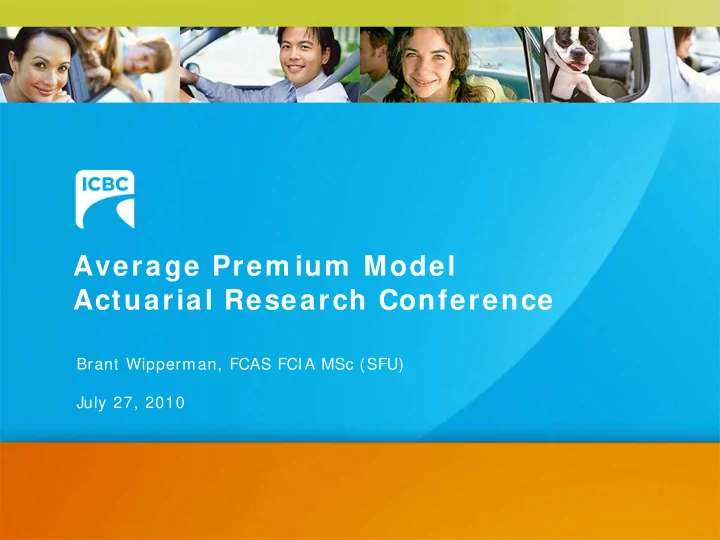

Average Prem ium Model Actuarial Research Conference Brant Wipperman, FCAS FCIA MSc (SFU) July 27, 2010
Motivation • Revenue Requirements • Monitoring our book of business 1
Basic On-Level Average Premium 630 A 625 v g 620 . P 615 r e m 610 i u 605 m ( 600 $ ) 2002 2003 2004 2005 2006 Year 2
Personal TPL On-Level Avg. Premium 630 A 625 v g 620 . P 615 r e m 610 i u 605 m ( 600 $ ) 2005 2006 2007 2008 2009 Year 3
Overview Exposure PCA Forecasts Average Premium Forecasts 4
Exposure Model • Historical exposure data – Split into Personal and Commercial – Further split into vehicle use, location, and bonus-malus groups • An econometric regression model is fit to each group – Demographic – Economy 5
Vehicle Use Groups • Personal – Pleasure – Commute – Business – Senior – Motorcycle – Motor home – Collector 6
Location Groups Lower Mainland • Ridge Meadows • Fraser Valley • Squamish/ Whistler • Pemberton/ Hope • Okanagan • Kootenays • Cariboo • Prince George • Peace River • North Coast • South Island • Mid Island • North Island • 7
Bonus-Malus Groups • Claim Rated Scale – Roadstar (43% discount) – 25% to 40% discount – 5% to 20% discount – Base or surcharge 8
Overview External Historical Factors Econometric Exposure Factor Models Data Forecasts Exposure PCA Forecasts Exposure Model Average Premium Forecasts 9
Historical Exposure Data • Too many groups for the average premium model • Need a dimension reduction technique • Want to keep all of the groups • Linear dependencies exist 10
What is PCA? • It transforms a number of correlated variables into a smaller number of uncorrelated variables • Uses linear algebra 11
PCA Notation = ⋅ T 1 A ( Z Z ) n ⋅ = λ A V V − = ⋅ 1 B V L 2 = ⋅ P Z B = ⋅ = ⋅ 1 S V L B L 2 = ⋅ T C T T 12
Eigen Decomposition • Linear algebra problem • Done on correlation matrix of explanatory variables • Eigenvectors are new explanatory variables (i.e. principal components) • Each associated eigenvalue represents variability of eigenvector (or PC) 13
PCA Resolves the Issues • Number of dimensions reduced • All groups ‘retained’ • Linear dependencies eliminated 14
PCA PCA Process • Step 1: Create new set of explanatory variables • Step 2: Determine how many new explanatory variables to retain 15
How many components? 35% % 30% o 25% f 20% V a r 15% i a 10% n c 5% e 0% 1 2 3 4 5 6 7 8 9 1011121314151617181920212223242526272829303132 Principal Com ponent 16
How many components? 88% 94% 100% 90% % 80% o 70% f 60% V 50% a r 40% i 30% a n 20% c e 10% 0% 1 2 3 4 5 6 7 8 9 1011121314151617181920212223242526272829303132 Principal Com ponent 17
Overview External Historical Factors Econometric Exposure Factor Models Data Forecasts Exposure PCA Forecasts Exposure Model Chosen PCs 18
Historical Exposure 30 correlated variables Data Ortho-normal transformation Principal 30 uncorrelated variables Components Scree Proportion of variance Other Chosen PCs 6 uncorrelated variables 19
Overview External Historical Factors Econometric Exposure Factor Models Data Forecasts Exposure PCA Forecasts Exposure Model Historical Linear Chosen PCs Regression Average Models Premium Chosen PC Forecasts Average Premium Forecasts Average Premium Model 20
Modeled vs. Actual – Personal TPL 660 A v 640 g . P 620 r e m 600 i u m 580 ( $ Jan-04 Jan-05 Jan-06 Jan-07 Jan-08 Jan-09 Jan-10 Jan-11 ) Month Modeled Actual 21
Modeled vs. Actual – Personal TPL 630 A 625 v g 620 . P 615 r e 610 m i u 605 m 600 2004 2005 2006 2007 2008 2009 2010 2011 Year Actual 6 PCs 4 PCs 8 PCs 22
Recap - Advantages • PCs uncorrelated • PCs organized to reduce dimensionality • Keeps most of original information • Determine contribution of each variable 23
Recap - Disadvantages • PCA process not familiar • PCs can be hard to interpret • PC weights may change upon updating 24
Is PCA Right For You? • Does multi-collinearity roll off your tongue too easily? • Are you confident in the set of explanatory variables? • Do you want to reduce dimensionality without throwing away information? • Have you been modeling for more than 4 consecutive hours? 25
For More Information • CAS Discussion Paper – PCA and Partial Least Squares: Two Dimension Reduction Techniques for Regression • http: / / www.casact.org/ pubs/ dpp/ dpp08/ 08dpp76.pdf 26
Recommend
More recommend